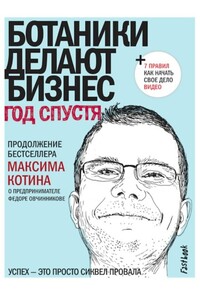Реклама. Принципы и практика [заметки]
1
Anusree Mitra and John G. Lynch Jr., «Towards a Reconciliation of Maket Power and Information Theories of Advertising Effects on Price Elasticity», Journal of Consumer Research 21, (March 1995): 44–59.
2
Ad Age Special Report: «Cosmetic AdvertisingSpending by Category», Advertising Age (June 23, 2003): S-14.
3
John Barnett and Sandra Moriarti, Marketing Communications: An Integrated Approach, (Upper Saddle River NJ: Prentice-Hall, 1998): 14.
4
Tom Duncan and Sandra Moriarty, Driving Brand Value: Using Integrated Marketing to Manage Profitable Stakeholder Relationships, (New York: McGraw-Hill, 1997).
5
Peter D. Bennett, Dictionary of Marketing Terms (Chicago: American Marketing Association, 1988): 115.
6
John Gapper, «Why nobody sells the carwe really want?» Financial Times (June 29, 2004): 15.
7
Joshua Kulantzick, «Most Valuable Players», Entrepreneur (June 2003): 68–71.
8
Brian Steiberg and Susanne Vranica, «Chief Seeks to Help Leo Burnett Get Ins Groove Back», The Wall Street Journal (October 12, 2003): 12B.
9
Noreen O’Leary, «The Incredible Shrinking Account Exec», Adweek (May 26, 2003) 22.
10
Erin White, «Linking Agency Fees to Ad Success», The Wall Street Journal (March 29, 2004): B4.
11
Tom Duncan and Sandra Moriarty, Driving Brand Value: Using Integrated Marketing to Manage Profitable Stakeholder Relationships (New York: McGraw-Hill, 1998).
12
Duncan & Moriarty, 1998.
13
«Soung can be a trademark», The London Times Law Report (December 4, 2003): 73.
14
Robert J. Posch Jr., «Trademark Protection for Internet Domain Names», Direct Marketing (July 1998): 63–65.
15
Barbara Martinez, «Gap Faces suit over Eyewear Used in Ad», Wall Street Journal (January 6, 1998): B10.
16
Rebecca Flass, «Done That», Adweek (April 22, 2002): 21.
17
Anne Cunningham, «Commosense or Nonsense: Limiting First Amendment Protection of Commercial Speech», Proceedings of American Academy Conference, M. S. Shaw (ed.), (E. Lansing, MI: Michigan State University): 61–83.
18
Chris Adams, «Looser Lip for Food and Drug Companies?» Wall Street Journal (September 17, 2002): A4.
19
Doug McKenna, «Marketers Opt Outof Civil Society», Boulder Daily Camera (April 13, 2003): 38.
20
Nike Vs Kasky: «Case Dismissed», SriMedia Report (June 26, 2003). (www.srimedia.com/artman/publish/article-642.shtml; Wendy Melillo, «Ad Groups Back Nike In Supreme Court Brief», Adweek (March 3, 2003): 3; Adam M. Kanzer and Cynthia A. Williams, «The Future of Social Reporting Is on the Line», Business Ethics, 17: 4 (Winter 2003); Roger Parloff, «Can we talk?» Fortune (September 2, 2002): 102–110.
21
«Letter to congress Explaining FTC is new Deception Policy», Advertising Compliance Service (Westport, CT: Meckler Publishing, November 21, 1983) and Ivan Preston, «A Review of the Literature on Advertising Regulation», in Current Issues and Research in Advertising (1983), James H. Leigh and Claude L. Martin, eds. (Ann Arbor: University of Michigan Press): 2–37.
22
Robert E.Wilkes and Jams D. Wilcox, «Recent FTC Actions: Implications for the Advertising Strategists», Journal of Marketing 38 (January 1974): 55–56.
23
Jack Neff, «Duracell Agrees to Modify Robo-War Duck Ad», Advertising Age (February 6, 2002).
24
Tom McGhee, «Broomfield firm’s penalty for ad: Drugs Destroyed», Denver Post (April 18, 2002): 2C.
25
John J. Burnett, «Gays: Feelings about Advertising and Media Esed», Journal of Advertising Research (January-February 2000): 75–86.
26
Stephen P. Durchslag, «Agency Liability Extends to False Advertising Claims», Promo (October 1992): 17.
27
Deborah Vence, «FDA seeks ti clarify rules for pharma ads», Marketing New (March 3, 2003): 6.
28
Michael McCarthy, «Local ads stir up Utah controversy», USA Today (January 2, 2002): 78.
29
Eli Pariser, MoveOn.org e-mail (January 22, 2004).
30
Editorial, «Super Censured», The Boulder Daily Camera (January (January 30, 2004): 4B.
31
Robert Weller, «Breckenridge pulls ad campaign,» Boulder Sunday Camera (September 8, 2002): 3B.
32
Roy F. Fox, «Hucksters Hook Captive Youngsters», Mizzou (Summer 2002): 22–27.
33
Lee Anne Peck, «Foolproof or Foolhardy? Ethical Theory in Beginning Reporting Texts», Journalism & Mass Communication Educator 58 (Winter 2004): 343–63.
34
Robert Weller, «Breckenridge pulls ad campaign», Boulder Sunday Camera (September 8, 2002): 3B.
35
D. J. Ganahl, T. J. Princen, and S. B. Netzley, «A Content Analisys of Prime Time Commercials: A contextual Framework of Gender Representation», Broadcasrt Education Association, Las Vegas, NV(2001); M. R. Barner, «Sex-role stereotyping in FCC-mandated children’s educational television», Journal of Broadcasting & Electronic Media, 43 (1999) 551–64; S.Coltrane and M. Adams, «Work-family imagery and gender stereotypes: Television and the Reproduction of difference», Journal of Vocational Behaviour 50 (1997): 323–47.
36
Richard Linnert, «Take it like a man», Advertising Age (December 8, 2003): 40.
37
D. J. Ganahl, T. J. Princen, and S. B. Netzley, «A Content Analisys of Prime Time Commercials: A contextual Framework of Gender Representation», Broadcasrt Education Association, Las Vegas, NV(2001).
38
«Stereotypes of Women Persist in Ads», Wall Street Journal (October 17, 2003): B4.
39
D. J. Ganahl, S. B. Netzley, William Hoon, and Kwangok Kim, «The Culture Clash in Television Commercials: Mainstreaming Black Stereotypes into Primetime Prototypes», unpublished manuscript, (2003).
40
Michelle Wirth Felman, «Preventing Viagra’s Fall», Marketing News (August 31, 1998): 1, 8.
41
Joan Voigt, «Realistic or Offensive?» Adweek (September 2, 2003): 16–17.
42
Interview with Jean Kilbourne by Renee Montagne, NPR Morning Edition transcript (June 22, 2004).
43
Robert Gustafson, Mark Popovich, and Steven Thomsen, «The ‘thin ideal’». Marketing News (March 15, 1999): 22.
44
Herbert Rotfeld, «Desires Versus the Reality of Self-Regulation», Journal of Consumer Affairs 37 (Winter 2003): 4244–27; Nanci Hellmich, «Weight-loss deception found ads for many of those pills, patches, creams and wraps are grossly exaggerated», USA Today (2002).
45
Joe Morgan, «Barclays forced to withdraw0 % campaign by OFT», The London Times (November 19, 2003): 4M.
46
Herbert J. Rotfeld and Kim B. Rotzoll, «Is Advertising Puffery Believed?» Journal of Advertising 9:3 (1980): 16–20, 45.
47
Barry Newman, «Ad Ad Professor Huffs Against Puffs, but It Is a Quixotic Enterprise», Wall Street Journal (January 24, 2003): A1; Ivan Preston, «A Problem Ignored: Dilution and Negation of consumer Information by Antifactual Content», Journal of Consumer Affairs 36 (Winter 2002): 263–83; Ivan Preston, «Dilution and Negation of Consumer Information by Antifactual Content: Proposals for Solutions», Journal of Consumer Affairs 37 (Summer 2003): 1–21.
48
Stephanie Thompson, «Food fight: Kraft beats back critics», Advertising Age (January 20, 2003): 1, 37.
49
Betsy Spethmann, «Tobacco’s Two Tiers», Promo Magazine (January 2004): 24–28.
50
Deborah Vence, «Match Game», Marketing News (November 11, 2002): 1, 11–2.
51
Wendy Melillo, «FTC Reviews Ad Plans from Alcohol Clients», Adweek (May 26, 2003): 8.
52
Christopher Lawton, «Lawsuits Allege Alcohol Market Target Youth», Wall Street Journal (February 5, 2004): B1; Ira Teinowitz, «Marketers blast charges in alcohol suit», Advertising Age (December 1, 2003): 10.
53
Chuck Ross and Ira Teinowitz, «Beer Ad Has Wide Underage Reach on MTV», Advertising Age (January 6, 1997):4; Ira Teinowitz, «LFTC Governing of Beer Ads Expands to Miller, A-B», Advertising Age (April 17, 1997): 1–50.
54
Bill McInturff, «While Critics May Feet, Public Likes DTC Ads,» Advertising Age (March 26, 2001): 24; David Goetzi, «Take a Heaping Spoon-ful», Advertising Age (November 6, 2000): 32; Angetta McQueen. «Watchdog Blames Ad Spending for High Drug Costs», The Denver Post (July 11, 2001): 4c.
55
Gene R. Laczniak and Patrick E. Murphy, «Fostering Ethical Marketing Decisions», Journal of Business Ethics 10 (1991): 259–71.
56
Carter McNamara, «Complete guide to Ethics Managemebt: An Ethics Toolkit for Managers», Authenticity Consulting (http://www.managementhelp.org/ethics/ethxgde.htm). April 2004.
57
«Public Rates Nursing as Most Honest and Ethical Profession», December 1, 2003 (www.gallup.com), April 2004.
58
Peck, 2004.
59
Ennis Higgins, «Conversations with David Ogilvy». In The Art of Writing Advertising (Chicago: Advertising Publications, 1965).
60
Simon London, «Choked by a data surfeit», Financial Times (January 29, 2004, 9).
61
Thomas Bary and Daniel Howard, «A Review and Critique of the Hierarchy of Effects in Advertising», International Journal of Advertising (9:2, 1990): 429–35; Michael Ray, «Communication and the Hierachy of Effects», in New Models for Mass Communication Research, P. Clarke, ed. (Beverly Hills, CA: Sage Publications, 1973): 143–75.
62
Ivan Preston, «The Association Model of the Advertising Communication Process», Journal of Advertising 11:2 (1982): 3–14.
63
«Stuart Elliot/In Advertising: Would You Trust Mini-me with Your Money», New York Times Direct, May 20, 2003, NY Times.com.
64
David Stewart and David Furse, Television Advertising: A Study of 100 °Commercials, Lexington, MA-Lexington Books, 1996).
65
John D. Morris, Chongmoo Woo, James Geeson, Jooyoung Kim, «The Power of Affect: Prediction Intention,» Journal of Advertising Research, (May/June 2002): 7–17.
66
ussel I. Haley and Allan L. Baldinger, «The ARF Copy Research Validity Project», Journal of Advertising Research, (April/May 1991): 11–32.
67
Ivan Preston, «The Association Model of the Communication Process», Journal of Advertising 3 (1982): 3–14.
68
Bill Wells, «How Advertising Works», speech to St. Louis AMA, September 17, 1986.
69
Daniel J. O’Keefe, Persuasion: Theory and Research, (Newbury Park, CA: Sage, 1990, 17).
70
Stewart Elliot, «HP Promotes High-Tech Recycling», New York Times Direct, July 29, 2003, NYTimes.com
71
Scott McCarthy, «Your Free Flight To Maui is Hobbing the Airline Industry», Wall Street Journal (February 4, 2004): D1.
72
Herbert Krugman, «The Impact of Television Advertising: Learning Without Involvement», Public Opinion Quarterly, (29:3, 1965): 349–56.
73
John Rossiter, Larry Percy and Robert Donovan, «A Better Advertising Planning Grid», Journal of Advertising Research (October/November, 1991): 11–21.
74
Lee Bowman, «Drag ads can influence patients», Daily Camera (February 26, 2003): 11.
75
John Fetto, «One Size Doesn’t Fit All: Today’s Working Mothers Defy the Label ‘Soccer Mom,’» American Demographics (May 200): 44–45.
76
Mary Sutler and Laurel Wenitz, «U. S. Conexciones», Advertising Age (July 16, 2001): 14.
77
Mindy Charsky, «Old Navy to Tailor Message to Hispanics», Adweek (August 4, 2003): 9.
78
Jack Neff, Hillary Chura, «Buyer Cross Borders», Advertising Age (March 3, 2003): 54.
79
Gary Silverman, «Hispanics in Tune with TV Advertising», Financial Times (March 4, 2004): 18.
80
Joan Davis, «Blacks in Black and White», PROMO (August 2000): 37.
81
Jennifer Lach, «The Color of Money», American Demographics (February 2000): 59–60.
82
Arundhati Parmar, «Knowledge of Mature Market Pays Reward», Marketing News (April 28, 2003): 5–6.
83
Thomas T. Semon, «Income Is Not Always Predictor of Spending», Marketing News (March 31, 2003): 6.
84
Winston Fletcher, A Glittering Haze (Henley-on-Thames, UK: NTC, 1992).
85
James W. Peltier, John Schibrowsky, Don Schultz, and John Davis, «Interactive Psychographics: Cross-selling in the Banking Industry», Journal of Advertising Research (March/April 2002): 7–22.
86
Joseph T. Plammer, «The Concept and Application of Life-Style Segmentation», Journal of Marketing (January 1974): 34.
87
David Lipke, «Head Trips», American Demographics (October 2000): 38–40.
88
Yuri Kageyama, «The ‘Cool Hunter’ in Japan», Boulder Daily Camera (February 7, 2004): E1.
89
Karl Weiss, тезисы к курсу лекций IMC Marketing Research, University of Colorado, January 2001.
90
Инсайт – часто употребляемый англоязычный термин, который используется в рекламной практике для обозначения «открытия», ключевого факта или специфической характеристики, которая является ключом к пониманию поведения потребителей. – Примеч. науч. ред.
91
Аудит рекламы – устойчивое выражение, которое означает исследование, проводимое с целью проверки рекламных материалов по каким-либо критериям. – Примеч. науч. ред.
92
Бэтмэн – «человек – летучая мышь», популярный персонаж американских комиксов, таинственный носитель добра и справедливости. – Примеч. науч. ред.
93
«Analysis of Commercials: OnStar and Batman», http://student.claytonstate.net/~csu11197/3901/project1/.
94
Roger Wimmer and Josef Dominick, Mass Media Research, 7th ed. (Belmont CA: Wadsworth/Thomson Learning, 2003).
95
Weiss.
96
В исследовательской практике респондентами на фокус-группах могут быть представители любых целевых групп и сегментов. – Примеч. науч. ред.
97
Dennis W. Rook, «Out-Of-Focus», Marketing Research (Summer 2003): 10–15; Alison Stin Wellner, «The New Science of Focus Groups», American Demographics (March 2003): 29.
98
Susan Mendelsohn, личное сообщение, December 20, 2003.
99
Leigh Ann Steere, «Culture Club», Print, (March/April, 1999): 4–5.
100
Shay Sayre, Qualitative Methods for Marketplace Research (Thousand Oaks: CA: Sage Publications, 2001), 31.
101
Дискаутер – магазин, которые предлагает товары по более низким ценам, чем конкуренты. дискаутеры обычно отличаются скромным оформлением торговых залов, отказом от использования дорогостоящего торгового оборудования, минимальным сервисом. – Примеч. науч. ред.
102
Russel W. Belk, ed., Highways and Buyways: Naturalistic Research from the Consumer Behavior Odyssey (Provo UT: Association for consumer Research, 1991).
103
Sayre, 20.
104
Thomas Davenport, Jeanne Harris, Ajay Kohli, «How Do They Know Their customers So Well?» MIT Sloan Management Review (Winter 2001): 63–72.
105
Gerry Khermouch, «Consumers in the mist», Business Week (February 26, 2001): 92–93; Alison Stein Wellner, “Research on a Shoestring,” American Demographics (April 2001): 38–39.
106
Wellner, «Research on a Shoestring».
107
Roy S. Johnson, «Banking on Urban America», Fortune (March 2, 1998): 129–32.
108
Emily Eakin, «Penetrating the Mind by Metaphor», February 23, 2002, NYTimes.com.
109
Sandra Yin, «New or Me Too», American Demographics (September 2002): 28.
110
В данном контексте под артефактами понимаются материальные свидетельства различных событий в жизни личности. – Примеч. науч. ред.
111
Mendelsohn.
112
Robin Couler, Gerald Zaltman, and Keith Koulter, «Interpreting Consumer Perceptions of Advertising: An Application of the Zaltman Metaphor Elicitation Technique», Journal of Advertising 30: 4 (Winter 2001): 1–14; Emili Eakin, «Penetrating the Mind by Metaphor», February 23, 2002 NYTimes.com; Daniel Pink, «Metaphor Marketing», Fast Company, http://www.fastcompany.com/magazine/14/zaltman.html; HBS Division of Research, The Mind of the Market Laboratory, «ZMET», http://www.hbs.edu/mml/zmet.html.
113
Catherine Arnold, «Hershey Research Sees Net Gain», Marketing News (November 25, 2002): 17.
114
Paula Kephart, «Virtual Testing», Marketing Tools (June 1998).
115
«Comfort Zone», Adweek Special Planning Section (July 3, 1998): 31.
116
Tom Duncan and Sandra Moriarty, Driving Brand Value: Using Integrates Marketing to Manage Profitable Stakeholder Relationships, (New York: McGraw-Hill, 1997).
117
Reseach for R. O. I.: Communications Workshop, Chicago: DDB Needham (April 10, 1987).
118
В российской практике выражение account-planner применяется крайне редко. Функции такого специалиста обычно делят между собой менеджер по исследованиям и менеджер по стратегическому планированию. – Примеч. науч. ред.
119
«What Is Account Planning? (and what do account planners do exactly?)», Account Planning Group (APG), http://www.apg.org.uk.
120
Susan Mendelsohn, personal communication, January 8, 2004.
121
Margaret Morrison, Tim Christy, Eric Haley, «The Integration of Account Planning In U. S. Advertising Agencies», Advertising Division, Association for Education in Journalism and Mass Communication, 2002 National Conference, Kansas City, MO.
122
Laurie Freeman, «Planner ‘Puts Clients in Touch with Souls of Brands», AdAge.com, February 8, 1999; http://www.adage.com/news.cms?newsID=34705.
123
Jon Steel, Truth, Lies and Advertising: Art of Account Planning, (New York Wiley, 1998); «Tests ahead for account planning», Advertising Age (September 20, 1999): 36.
124
Термин brief (бриф) является устойчивым выражением и используется в российской рекламной и исследовательской практике без перевода. – Примеч. науч. ред.
125
Duncan and Moriarty.
126
Jon Fine, «Newspaper-industry Slide Worsens», Advertising Age (May 10, 2004): 59.
127
James Poniewozik, «The People’s Paper», Time (July 21, 2003): 49–50.
128
Laurel Wentz and Mercedes Cardona, «Newspapers Turn to Hispanics», Advertising Age (January 5, 2004): 16.
129
«Media», 2003 Marketing Fact Book (July 7, 2003): 17.
130
Kim Long, The American Forecaster Almanac, 1993 Business Edition.
131
Magazine Reader Experience Study, Chicago: Northwestern University Media Management Center, www.mediamanagementcenter.org.
132
Anne Marie Kerwin, «Magazines BlastStudy Showing Reader Fallof», Advertising Age (March 8, 1999): 13, 55.
133
Elizabeth H. Weise, «On-Line Magazines: Will Readers Still WantThem after the Novelty Wears Off», The Marketing News (January 29, 1996): 1, 14.
134
Jonathan Asher, «Make the Most of Packaging Design Updates», Marketing News (September 18, 2000): 13.
135
Cathy Frisinger, «Label Cuisine Remains an American Favorite», The Tampa Tribune (January 21, 2004): 3.
136
Stuart Elliott, «Selling ‘Nothing’», March 16, 2004, NYTimes.com
137
«Media», 2003 Marketing Fact Book (July 7, 2003): 17.
138
The Signage Sourcebook (South Bend, IN: The Signage Foundation, 2003).
139
Rebecca Gardyn, «Mowing Targets», American Demographics (October 2000): 32–34.
140
Almar Latour, «Amid High-Tech Turf Battles, Baby Bells Feel Heet on Cash Cow», Wall Street Journal (April 13, 2004): A1.
141
Latour.
142
Eugenia C. Daniels, «Critical Shift in Direction», Advertising Age (February 14, 2000): S12
143
Leigh Gallagher, «Prairie Home Commercial», Forbes (August 6, 2001): 54–55.
144
Beth Snyder, «Rolling Stone Radio Seeks New Revenue, Expands Mega Brand», Advertising Age (November 2, 1998): 40.
145
Steve Jarius, «Marketing Issues Raised by LPFM Stations», Marketing News (August 28, 2000): 7.
146
«Marketing Fact Book», специальная вкладка, Marketing News (July 15, 2004): 4.
147
Joan Raymond, «Radio-Active». American Demographics (October 2000): 28–29.
148
Alex Veiga, «Marketers Use Free CDs to Promote New Artists». Daily Camera (July 1, 2003): E1.
149
Jonathan Karp, «Hey, You! How About Lunch?» Wall Street Journal (April 1, 2004): B1.
150
Bob Garfield, «Why TV Can Only Get Better,» AARP Bulletin (April 2004): 10; John Consoli, «The Case of the Missing Young Male TV Viewers», Adweek (October 20, 2003): 7.
151
Christopher Reynolds, «The Lost Demo», Promo Magazine (February, 2004): 16–17.
152
Michael Mc-Carthy, «Forecast: Public to Turn to Paid Media», USA Today (August 15, 2003): 12B.
153
May Wong, «TiVo Views Clones as a Threat», The Denver Post (April 26, 2004): 2C; Eroc Taib, «Cannot Imagine TV Without TiVo», The Denver Post (March 22, 2004): 5C.
154
Rudy Martzke, «Super bowl Ratings Edge Up», USA Today (February 2, 2004): 1.
155
Brooks Barnes, «Nielcen Postpones New York Launch of Rating System», Wall Street Journal (April 17, 2004): B3.
156
(Автор неизвестен) «Is the End of the Ad Slump in Sight?» Fortune (January 12, 2004) p.48.
157
Alastair Ray, «Own-brand Broadcaster Tunes In», Financial Times (March 16, 2004) p.10.
158
Terry Lefton, «You Can’t Zap these Ads», The Industry Standard (March 26, 2001): 54–55; James Poniewozik, «This Plug’s For You», Time (June 18, 2001): 76–77
159
www.census.gov.
160
Jefferson Graham, «For Google, Many Retailers Eagerly Jump Through Hoops», USA Today (February 5, 2004): 1.
161
Dan Gillmore, «Blogs Getting Serious About Themselves», Denver Post, (April 26, 2004): 5C.
162
Marcus Lillkwist, «Blogs are Growing Up: Ads on the sites are Taking off,»» Business Plus (March 22, 2004): 13.
163
Susanne Vranica, «U. S. Ad Spending Rose6,1 % in 2003», Wall Street Journal (March 9, 2004): B6.
164
Lillkvist.
165
Mylene Mangalindan, «Web Ads on the Rebound After a Multiyear Slump: Online Marketing Gets a Lift by Broadband, New Formats», (August 25, 2003): B1.
166
Tobi Elkin, «Marketing Beyond the Pop-Up», Advertising Age (March 10, 2003): 4.
167
Jack Hitt, «Confessions of a Spam King,» New York Times Magazine, September 28, 2003, NYTimes.com.
168
«News Beer Uses Pre-Launch Viral Email Vote to turn Consumers into Evangelists,»» June 24, 2003, www.MarketingSherpa.com.
169
Peter Fancese, «Media Blitzed», American Demographics (February 2004): 40–41.
170
Pamela Paul, «Nouveau Niche», American Demographics (July/August 2003): 20–21.
171
Theresa Howard, «Brands Becoming Stars of the Show», USA Today, April 9, 2003, p.B1; Kate Macarthur, «Branded Entertainmebt, Marketing Tradition Tussle», Advertising Age (May 10, 2004): 6; Ruth Mortimer, «In the Picture: How Brands are Muscling in on Content», Brand Strategy (May 2003): 10–11.
172
Tobi Elkin, «Marketing Beyond the Pop-Up», Advertising Age (May 10, 2003): 4.
173
Brian Steinberg and Suzanne Vranica, «Burger King Seeks Some Web Heat», Wall Street Journal (April 15, 2004): B3.
174
Laura Rich, «That’s Advertainment», The Industry Standard (June 25, 2001): 60–62.
175
Randall Rothenberg, «Ad of the Month», Fast Company (March 2003): 40.
176
«AmEx Plans Jerry Seinfeld-Meets– Superman Internet Show», Advertising Age, February 4, 2004, AdAge.com.
177
Kevin Delaney and Robert Guth, «Beep.Foosh.Buy.Me.Pow», Wall Street Journal, (April 8, 2004): B1; Christopher Parkes, «Nielsen to Interact with Gaming Group», Financial Times (April 8, 2004): 24.
178
Richard Linnett, «Starcom’s Play Targets Gamers», Advertising Age (June 9, 2003): 3.62.
179
Delaney and Guth.
180
Pamela Paul.
181
Marcia Dunn, «The Space for Sale», Sunday Camera (October 14, 2001): IDD.
182
Mark Harper, «Mobile Campaign Rootes Around for Truth in Politics», Daytona Beech News-Journal (May 26, 2004): 3c.
183
«Best Practice: Television Planning», Admap (June 2002): 11–12.
184
Hugh Cannon, John Leckenby, Avery Abernethy, «Beyond Effective Frequency: Evaluating Media Schedules Using Frequency Value Planning», Journal of Advertising Research (November/December 2002): 33–47.
185
Admap.
186
Ian Brace and Louise Edwards, «Can Advertising Reach Everybody?» Adweek (July/August, 2002):26–28.
187
«The Medium Shapes the Message», Business 2.0 (July, 2003): 32.
188
Maura Clancey and Gale Metzger, «Building Survey-based, Media-mix Tool», Admap (June 2002): 47–49.
189
Hank Bernstein and Kate Lynch, «Media Scheduling and Carry-over Effects», Admap (October 2002): 40–42.
190
Kate Fitzgerald, «Trolling for Media Plan’s Role», Advertising Age Special Report (March 3, 2003): S10–S12.
191
Claire Atkinson, «Coke Catapults Starcom MediaWest», Advertising Age (February 9, 2004): S6, S10.
192
Bardley Johnson, «Cracks in the foundations», Advertising Age (December 8, 2003): 1, 10.
193
Don E. Schultz, «Outdated Approach to Planning Needs Revamping», Marketing News (November 11, 2002).
194
Clancey and Metzger.
195
A.Jerome Jewler and Bonnie L. Drewniany, Creative Strategy in Advertising (Belmont, CA: Wadsworth/Thompson Learning, 2001), 3.
196
Jerry Moore and William D. Wells, R. O. I. Guidebook: Planning for Relevance, Originality and Impact in Advertising and Other Marketing Communications (New York: DDB Needham, 1991).
197
Alisa White, Bruce Smith, and Fuyuan Shen, «Rating creativity: Do advertising professionals and educators apply the same standards?» Journal of Advertising Education, 6:2 (Fall 2002): 37–46.
198
James Webb Young, A Technique for Producing Ideas, 3d ed. (Chicago: Crain Books, 1975).
199
John Eighmy, The Creative Work Book (Iowa City: University of Iowa, 1998),1.
200
Thomas Russell and Glenn Verrill, Kleppner’s Advertising Procedure, 14th ed. (Upper Saddle River, NJ: Prentice Hall, 2002), 457.
201
Linda Convey Correll, «Creative Aerobics: A Technique to Jump-Start Creativity», Proceedings of the American Academy of Advertising Annual Conference, Carole M. Maclin, ed. (Richmond, VA:, 1997): 263–64.
202
Shery J. Broyles, «The Creative Personality: Exploring Relations of Creativity and Opennes to Experience», из неопубликованной докторской диссертации, Southern Methodist University, Dallas, 1995.
203
Broyles, «The Creative Personality».
204
A.Kendrick, D. Slayden, and S. J. Broyles, «Real Worlds and Ivory Towers. A Survey of Top Creative Directors», Journalism and Mass Communication Educator 51(2) (1996a): 63–74; A.Kendrick, D. Slayden, and S. J. Broyles, «The Role of Universities in Preparing Creatives: A Survey of Top U. S. Agency Creative Directors», Proceedings of the 1996 Conference of the American Academy of Advertising, ed. G. B. Wilcox (Austin: University of Texas, 1996 b): 100–106.
205
Graham Wallas, The Art of Thought (New York: Harcourt Brace, 1926); Alex F. Osborn, Applied Imagination, 3d ed. (New York: Scribner’s, 1963).
206
Sandra Moriarty and Brett Robbs, «Advertising», Encyclopedia of Creativity, Vol.1 (San Diego, CA: Academic Press, 1999), 23–29.
207
William Wells, «How Advertising Works», speech to the St. Louis AMA, September 17, 1996.
208
Blythe Yee, «Ads Remind Women They Have Two Hands», Wall Street Journal (August 14, 2003): B5.
209
Jane Levere, «Celebrities Help Publisize National Parks», The New York Times Direct, August 5, 2003, [email protected].
210
Stuart Elliott, «The Risky Business of ‘Shockvertising’», The New York Times Direct, February 10, 2004, [email protected].
211
Rick Boyko, «Re-defining the ad», one.a magazine (Winter 2003): 4–5.
212
Betsy Sharkey, «Super Anst», Adweek (January 24, 1993): 24–33.
213
Yumiko Ono, «Some Times Ad Agencies Mangle English Deliberately», Wall Street Journal (November 4, 1997): B1.
214
David Ogilvy, Ogilvy on Advertising (New York: Vintage, 1985).
215
Cynthia Crossen, «Clever Line/Make Us Crave/Return to Days/Selling Burma-Shave», Wall Street Journal (August 20, 2003): 1A.
216
Sandra Dallas, «Road to Pave? Remember Burma-Shave!» Business Week (December 30, 1996): 8; Frank Rowsome Jr., The Verse by the Side of the Road (New York: Dutton, 1965).
217
Paul D. Bolls and Ribert F. Potter, «I Saw It on the Radio: The Effects of Imagery Evoking Radio Commercials on Listeners’ Allocation of Attention and Attitude toward the Ad», Proceeding of the Conference of the American Academy of Advertising, Darrel D. Muehling ed. (Lexington, KY, 1998), 123–30.
218
Peter Hochstein, «Ten Rules for Making Better Radio Commercials», Ogilvy & Mather’s Viewpoint (1981).
219
Адаптировано из A. Jerome Jewler and Bonnie Drewniany, Creative Strategy in Advertising, 7th ed. (Belmont, CA: Wadsworth, 1992): 164–65.
220
Адаптировано из John Barnett and Sandra Moriarty, Marketing Communications: An Integrated Approach (Upper Saddle River, NJ: Prentice-Hall, 1998), 296–97.
221
Blessie Miranda and Kuen-Hee Ju-Pak, «A Content Analysis of Banner Advertisements: Potential Motivation Features», Annual Confernce Baltimore, AEJMC, August 1998.
222
Sandra Dolbow, «Brand Builders», Brandweek (July 24, 2000): 19.
223
Sandra Ernst Moriarty, The ABC of Typography, 2nd ed. (Glenbrook, CT: Art Direction Book Company, 1996).
224
Noreen O’Leary, «Legibility Lost», Adweek (October 5, 1987): D7.
225
Steve Jarius, «Marketing Issues Raised by LPFM Stations», Marketing News (August 28, 2000): 7.
226
Lisa Spiller and Martin Baier, Contemporary Direct Marketing, (Upper Saddle River, NJ: Prentice Hall, 2004).
227
Pradeep K. Korgaonkar, Eric J. Karson, and Ishael Akaah, «Direct Marketing Advertising: The Assents, the Dissents, and the Ambivalents», Journal of Advertising Research (Sempember/October 1997): 41–45.
228
Spiller and Baier, 44.
229
Matt Hasan, «Ensure success of CRM with a change in mindset», Marketing News (April 14, 2003): 16.
230
Daniel Lyons, «Games Dealer Play», Forbes (October 18, 1998): 132–34.
231
Stan Rapp and Tom Collins, Maximarketing (New York: McGraw-Hill, 1987).
232
Dean Rieck, «10 Basics for Writing Better Letters», Direct Marketing 3 (12) (April 2001): 52–53, 62.
233
Khozen Merchant, «Telesales called to account», Financial Times (March 29, 2004): 20.
234
Jonathan D. Salant, «Rules Require telemarketer identification», Boulder Daily Camera (January 29, 2004): 4E.
235
David Streitfeld, «Marketers dialing before Oct.1», Boulder Sunday Camera (August 24, 2003): F1.
236
Christine Tatum, «No-call lists force sellers to adjust», The Denver Post (January 25, 2004): 1K.
237
«Telemarketing Sales Rule Reaces Fifth Anniversary», Direct Marketing 64 (2) (June 2001): 8.
238
Stan Rapp and Tom Collins, Maximarketing (New York: McGraw-Hill, 1987).
239
Lance Arthur, «Clear cut lessons foe effective E-mail», Direct Marketing 64 (1) (May 2001): 6263.
240
«Targeting spammers», Boulder Daily Camera (December 26, 2003): 18A.
241
Dennis Berman, «Could Spam One day End Up Crushed Under Its own Weight?» (August 25, 2003): B1.
242
Fiona Harvey and Scott Morrison, «Amazon steps up fight against junk e-mail with legal action on ‘spoofers’» Financial Times (August 27, 2003): 1.
243
Clint Talbott, «‘Spam king’ didn’t opt for this call», Boulder Daily Camera (January 30, 2004): 5B.
244
Janis Mara, «E-mail Direct», Adweek (April 10, 2001): 116–17.
245
Davib McNickel, «Deeper, Closer, Faster, Smarter», AdMedia (April 2003): 36.
246
Russ Brown, «Sales Promotion», Marketing & Media Decisions (February 1990): 74.
247
Council of Sales Promotion Agencies, Shopping the Future of Sales Promotion (1990): 3.
248
2001 Annual Report, Promo (May 1, 2001),?? www,industryclick.com/magazinearticle.asp?magazinearticleid=99739&.
249
«Upward Bound,» Promo, April 1, 2004, http://promomagazine.com/mag/marketing_upward_bound/index.html.
250
«Upward Bound».
251
«Upward Bound».
252
Dave Carpenter, «McDonald’s unweils new game, but stock hits 10-year low», The Associated Press State & Local Wire (March 6, 2003), http://web.lexis-nexis.com/universe/document?_m=e0607584954c0d52b07aa058.
253
«Entertainment Marketing Awards: Who’s Who», Promo Special Reports, May 1, 2001, www.industryclick.com/Microsites/Newsarticle.asp?newsarticled=218986&srid=.
254
Matthew Kinsam, «The Last Stand», Promo (January 2001): 29–34.
255
Sam Walker, «The Bankers Behind the Woman», Wall Street Journal (May 23, 2003): W5.
256
Christine Tatum, «Firms more thoughtful in sponsoring of events», Denver Post (August 8, 2003): 4.
257
Emiko Terazono, «Ambush marketing tactics to be kicked into touch», Financial Times (September 2, 2003): 9.
258
«The Boomer Esiason foundation and Johnsonville Sausage Team Upfor Monday Night Football», PR Newswire, September 4, 2003, http://prnewswire.com.
259
«Upward Bound».
260
Elizabeth Boston, «Heineken Aims to Nab ‘Matrix’ Ad Limelight», Advertising Age (May 26, 2003): 30.
261
Dan Hanover, «We Deliver», Promo (March 2001): 43–45.
262
Bob Tedeschi, «A Growing Ad Strategy: ‘Click to Win!’» New York Times, August 21, 1998, www.nytimes.com/library/tech/98/08/cyber/articles
263
«Walking the Tight Rope», Promo (March 2001): 48–49.
264
Samantha Critchell, «Bad girl biker look popular for fall», Boulder Daily Camera (August 28, 2003): 4D.
265
Jacques Chevron, «Branding and Promotion: Uneasy Co-habitation», Brandweek (September 14, 1998): 24.
266
Scott Hume, «Rallying to Brand’s Resque», Advertising Age (August 13, 1990): 3.
267
Jon Kramer, «It’ time to Tie the Knot with Promotion», Integrated Marketing and Promotion,» (September/October 1998): 77.
268
2001 Annual Report, Promo.
269
www.psa.org/pressroom/aboutpr.html.
270
Martin Sorrell, «Assessing the State of Public Relations», The Strategist vol. 3(4) (Winter 1998), 48.
271
Doug Newsom, Alan Scott, and Judy Van Slyke Turk, This Is PR: The Realities of Public Relations, 4th ed. (Belmont, CA: Wadsworth, 1989), 99.
272
Claire Atkinson, «Rubinstein: PR Maestro», Advertising Age (October 11, 2004): 46.
273
Jackmes Lukaszewski, «Chief Integrity Officer is tailor-made for PR», Odwyer’s PR Services Report (March 2004): 8.
274
Tom Duncan and Sandra Moriarty, Driving Brand Value (New York: McGraw-Hill, 1997).
275
Luckaszewsky.
276
Kirk Hallahan, «No, Virginia, It’s Not True What They Say about Publicity’s “Implied Third-Party Endorsement” Effect», Association for Education in Journalism and Mass Communication Annual Conference (August1998, Baltimore, MD): 13.
277
Thomas L. Harris, Value-Added Public Relations: The Secret Weapon of Integrated Marketing (Lincolnwood, IL: NTC Business Books, 1998).
278
Sandra Moriarty, «IMC Needs PR’s Stakeholder Focus», AMA Marketing News (May 26, 2003), 115.
279
Fraser P. Seitel, The Practice of Public Relations, 9th. ed.(Upper Saddle River, NJ: Prentice Hall, 2003), 115.
280
Prema Naktra, «Corporate Reputation Management: ‘CRM’ with a Strategic Twist?» Public Relations Quarterly 45(2) (Summer 2000): 35.
281
Barbara Palframan-Smith, «Employee Connection», Communication World (March-April 2004): 7.
282
Bernard Charkand, «How Can Communicators Bridge the Gap Between Executives and Employees: Australia», Communication World (March-April 2004): 12.
283
Erwin Bettinghaus and Michael Cody, Persuasive Communication, 5th ed. (Fort Worth: Harcourt Brace, 1994), 7.
284
Tamara Gillis, «In Times of Change, Employee Communication Is Vital to Sucesfull Organizations», Communication World (March-April 2004): 8.
285
E. W. Brody, «Have Made the Transition? Are You Practicing Public Relations In the 21st Century Rather Than the 20th?» Public Relations Quarterly (Spring 2004): 7–9.
286
Claire Atkinson, «PR Firms Praise Janet Jackson Breast Stunt», AdAge.com, February 9, 2004, http://www.adage.com/newscoms?newsid=39756.
287
Harris.
288
Alyse R. Gotthoffer, «Exploring the Relevance of Localization in Anti-Drinking and Driving PSAs», in The Proceedings of the American Academy of Advertising Conference, Dan-el D. Muehling, ed. (Lexington KY, 1998), 214.
289
Edward A. Faruolo, «A Business of Caring», The Advertiser (October 1998): 36–40.
290
Thomas Harris, «iPod, Therefope iAm», ViewsLetter (September 2004): 3.
291
Cathy Cripps, «PR is more than just media», письмо редактору, Advetising Age (October 11, 2004): 24.
292
Andrea Tanner, «Communicating Health Information and Making the News», Public Relations Quarterly (Spring 2004): 36.
293
Carole Howard, «Working Wih Reporters: Mastering the Fundamentals to Build Long-Term Relationships», Public Relations Quarterly (Spring 2004): 36.
294
Fraser P. Seitel, «E-mail News Releases2, O’Dwyer’s PR Wservices Report (March 2004): 37.
295
Anne R. Owen, «Avant Garde or Passe: Using Video News Releases Internationally», in The Proceedings of the American Academy of Advertising Conference, Carole M. Macklin, ed., St. Louis:, 1997, 290.
296
Brody, 7–9.
297
Ben Tyson Sativa Ross, Steve Broderick, Susan Westa, «Getting Viewers to Your Website: A Study of direcu Mail CD-Rom Effectiveness», Public Relations Quarterly (Spring 2004): 18–23.
298
Marcia Xenitelis, «How Can Communicators Bridge the Gap Between Executives and Employees: Australia», Communication World (March-April 2004): 7.
299
Seitel, The Practice of Public Relations, 441.
300
Candace White and Niranjan Raman, «The World Wide Web as a Public Relations Medium», Association for Education in Journalism and Mass Communication Annual Conference (August 1998, Baltimore, MD).
301
Michelle O’Malley and Tracy Irani, «Public Relations and the Web: Measuring the Effect of Interactivity, Information, and Access to Information in Web Sites», AEJMC Conference, Baltimore, MD, August 1998.
302
Seitel, The Practice of Public Relations, 447.
303
Jill Whalen, «Online Public Relations», High Ranking Advisor, Issue 109, August 18, 2004 (http://www.highrankings.com/issue109.htm)
304
Michael Markowitz, «Fighting Cyber Sabotage», Bergen Record (October 4, 1998); retrieved online at http://www.bergen.com/biz/online04199810041.htm.
305
James E. Grunig, Excellence in Public Relations and Communication Management (Hillsdale, NJ: Erlbaum, 1992).
306
Kimberly Gill, «Searching for Excellence in Public Relations», Association for Education in Journalism and Mass Communication Annual Conference, Public Relation Division, Baltimore, MD, August 1998.
307
Stewart Elliott. «Luring Customers With Bait From the Future», New York Times, September 9, 2003, [email protected]
308
Jerome Jeweler and Bonny L. Drewniany, Creative Strategy in Advertising, 7th ed. (Belmont, CA: Wadsworth, 2001), 240–44.
309
Lorri Grant, «Retailers take a novel approach to advertising», Salt Lake Tribune (June 22, 2003): E2.
310
John A. Koten, «The Strategic Uses of Corporate Philantropy», in the Handbook of Strategic Public Relations and Integrated Communications, Clarke L. Caywood, ed. (New York: McGraw-Hill, 1997), 149.
311
«1999 Midsize Agency of the Year: Cone,» Inside PR (Winter 1999): 11.
312
Tom Duncan and Sandra Moriarty, Driving Brand Value: Using Integrated Marketing to Manage Profitable Stakeholder Relationships (New York: McGraw-Hill, 1997), 1997.
313
Nick Chiarelli, «Has the global consumer changed?» Admap (May 2003): 29–31.
314
Theodore Levitt, «The Globalization of Markets», Harvard Business Review (May-June 1983): S8–S9.
315
Philip Kotler, Marketing Management, 6th ed. (Englewood Cliffs, NJ: Prentice-Hall, 1988).
316
Morgen Witzel, «The quantifier of culture», Financial Times (August 26, 2003): 7.
317
Chiarelli, 29–31.
318
P&R External Relations Department and Jack Neff, «P&G Flexes Muscle for Global Branding», Advertising Age (June 3, 2002): 53.
319
Warren Kreegan and Mark Green, Global Marketing, 3rd ed. (Upper Saddle River NJ: Prentice Hall): 524–25.
320
Barbara Mueller, Dynamics of International Advertising (New York: Peter Lang, 2004).
321
Geoffrey Fowler, «China Cracks Down on Commercials», Wall Street Journal (February 19, 2004): B7.
322
Edward Hall, Beyond Culture (Garden City, NY: Anchor Press/Doubleday, 1976).
323
Colin Grimshaw, «Why Global Firms Need Local Media», Marketing (May 15, 2003): 27.
324
Geoofrey Fowler, «China’s Edgey Advertising», Wall Street Journal (October 27, 2003): B1.
325
Michael Solomon, Conquering Consumerspace: Marketing Strategies for a Branded World (New York: American Management Association, 2003); Arundhati Parmar, «Global youth united», Marketing News (October 26, 2002): 1, 49.
326
Там же.
327
Katherine Frith and Barbara Mueller, Advertising and Societies: Global Issues (New York: Peter Lang, 2002).
328
Andreas Grein and Stephen Gould, «Globally Integrated Marketing Communications», Journal of Marketing Communications (2: 1996): 141–58.
329
Tim Burt, «Veteran leads MTV’s attack», Financial Times (August 12, 2003): 6.
330
David Brandt and Dave Walker, «Copy Testing Under the Gun?» Ipsos Ideaas (August/ September, 2003): 3.
331
Tim Huberty, «Who’s Who in Ad Copytesting», Quirk’s Marketing Research Review (March 2002), www.quirks.com.
332
Charles E. Young, «Capturing the Flow of Emotion in Television Commercials: A New Approach», Journal of Advertising Research (June 2004): 202–09; Chuck Young and John Kastenholz, «Emotion in TV ads», Admap (January 2004): 40–42.
333
John Philip Jones, When Ads Work: New Proof That Advertising Triggers Sales (New York: Lexington Books, 1995).
334
Erwin Ephron, «Media Audit’s time is Come», Advertising Age (September 2, 2002): 16.
335
Richard Linnett, «Nissan Seeks Media Audit for $1B Acc’t», Advertising Age (January 5, 2004): 1, 24; Jack Feuer, «P&G Looks Outside For Media Auditing», Adweek (May 26, 2003): 6.
336
Julie Zdriarzki, «Evaluating Sponsorships», Promo (March 2001): 92–93.
337
Там же.
338
Jeff Miller, «Media measurement: it’s more than looking at ROI», O’Dwyer’s PR Services Report (March 2004): 13.
339
Там же.
340
Peter Vogt, «Awareness to Action», Communication World (March-April 2004): 22–26.
341
Jones, 1995.
342
Tom Duncan and Sandra Moriarty, Driving Brand Value: Using Integrated Marketing to Manage Profitable Stakeholder Relationships (New York: McGraw-Hill, 1997).
343
Lynn G. Coleman, «The Crunch Has Come», Marketing News (March 4, 1991): 16.
344
Warren Keegan and Mark Green, Global Marketing, 3rd ed. (Upper Saddle River, NJ: Prentice Hall, 2003), 241.

«Мое тело – мое дело!» – однажды громко заявила Тесс Холлидей, запустив волну восхищений и возмущений по всему миру. Теперь она смотрит на всех злопыхателей с обложки журнала Cosmopolitan и говорит: «Это мое время!» Эта книга – не просто исповедь толстой девчонки и не очередная история успеха – это мощный мотиватор для всех, кто когда-либо сомневался в себе. Тесс Холлидей прошла непростой путь от забитой девочки из неблагополучной семьи до самой скандальной и высокооплачиваемой модели плюс-сайз.

Первая и на текущий момент единственная большая книга о создании, ведении и развитии бизнеса интернет-магазина в России, написанная магазинщиком с 20-летним опытом в электронной коммерции, который до сих пор у руля. Книга описывает не только теоретические аспекты поиска ниши, планирования ассортимента и создания сайта, в ней автор рассказывает о своём многолетнем практическом опыте создания, раскрутки и реорганизации интернет-магазинов. Речь пойдёт о логистике и складе, работе с поставщиками и партнёрами, сравнении передачи процессов на аутсорсинг или выполнении своими силами, о нюансах локальной и региональной доставки, самовывоза и многом другом. Также немало внимания уделено интернет-маркетингу.

Компания-легенда, история которой началась в тесной квартире учителя английского языка, а спустя всего 10 лет после основания достигла показателей продаж, значительно превышающих результаты eBay и Amazon, вместе взятых. Это рассказ, как никому не известному Джеку Ма и его 17 друзьям удалось сформировать отсутствующую интернет-индустрию в огромной – больше миллиарда жителей – стране. О людях, которые верили в себя и свое дело даже в самые тяжелые моменты – и сумели изменить мир.

Дизайнер в роли лидера? Это интересно! Джон Маэда – всемирно известный дизайнер, автор бестселлера «Законы простоты», один из наиболее влиятельных людей XXI в. по мнению журнала Esquire. Возглавив Род-Айлендскую школу дизайна, из профессора, не признающего авторитеты и любившего свободу и эксперимент, Маэда превратился в главу иерархической организации и вынужден был методом проб и ошибок учиться быть лидером. В своей новой книге он делится опытом и сводит воедино различные точки зрения на лидерство – художника и дизайнера, инженера и ученого, преподавателя и просто человека.

Вторая из серии книг о раскрытии секретов новых электронных денег. Книга познакомит с очередной звездой криптографии, оставляя читателю свободу самому решить – является ли Эфир очередной киберугрозой для мировой экономики, или платформа Ethereum – это просто логическая последовательность цифрового развития человечества. Параллельно с этим перед читателем раскроется более детально так нашумевшее название «смарт-контракт».

«И ботаники делают бизнес», необычная деловая книга о приключениях простого провинциального предпринимателя Федора Овчинникова, стала бестселлером 2011 года и получила премию «Выбор рунета». Продолжение книги рассказывает, что случилось с героем после того, как он продал свой бизнес за бесценок и остался ни с чем. Это вдохновляющая история о том, как человек, пережив неудачу, нашел в себе силы учесть ошибки и начать все с чистого листа – и что у него из этого получилось.

«Маркетинг для государственных и общественных организаций» – книга-откровение, предназначенная специально для работников государственной сферы. Она содержит десятки историй успеха госорганизаций всех типов и со всего мира. Всемирно известный эксперт Филип Котлер и консультант по социальному маркетингу Нэнси Ли показывают, что маркетинг – это не просто очередная статья расходов и отнюдь не только коммуникации, а целый комплекс мероприятий по повышению уровня жизни граждан. Книга познакомит вас с базовыми устоями маркетинга применительно к государственной сфере, научит применять маркетинговые инструменты с целью обретения поддержки граждан и воздействия на общественное мнение в целом.

Алгоритмы социальных сетей меняются с завидной регулярностью. Важно ли их знать? Конечно! За обновлениями нужно следить? Безусловно. Но давайте начистоту. Вы же пишете не для того, чтобы удивить роботов Инстаграма, верно? Что толку от знаний алгоритма формирования ленты в Фейсбуке, если ваши посты скучные? Вас читают люди, а не искусственный интеллект. Вам нужны эмоции, вы рассчитываете на продажи, верно? Алгоритмы сетей меняются – люди остаются людьми. Освойте приемы создания убедительных постов. Интересных, вовлекающих, вызывающих улыбку или грусть, желание действовать или остановиться.

Дмитрий Кот – один из самых известных копирайтеров, бизнес-тренер, директор Агентства продающих текстов, автор бестселлеров «Копирайтинг: как не съесть собаку. Создаем тексты, которые продают» и «Продающие тексты: модель для сборки. Копирайтинг для всех». Задумайтесь, почему клиент должен выбрать именно вас? Почему должен обратиться в вашу компанию, зайти в ваш магазин, а не к конкурентам по соседству? Есть убедительные причины, по которым нужно заплатить вашу, более высокую цену, чем в среднем по рынку? А вы уверены, что ваши аргументы будут достаточно вескими? Читайте новую книгу Дмитрия Кота, и вы узнаете: • как отстраиваться от конкурентов, чтобы клиент с первого раза понял: вы лучше других; • как, в каких текстах и где именно – на сайте или в рекламных материалах – нужно заявлять о своих отличиях и какие формулировки при этом использовать. «АпперКот» – это готовые приемы отстройки и внедрения конкурентных преимуществ.

Дмитрий Кот – один из самых известных копирайтеров, бизнес-тренер, директор Агентства продающих текстов, автор бестселлера «Копирайтинг: как не съесть собаку. Создаем тексты, которые продают».Книга для всех, кто пишет продающие тексты.Чем она отличается от десятка других книг по копирайтингу? Она дополняет их. Помогает систематизировать приемы и подходы: предлагает систему – вы понимаете, из каких блоков состоит текст и роль каждого из них; содержит готовые к внедрению формулы и шаблоны – бери и делай; раскрывает секреты, повышающие эффективность текстов; допускает вариативность поведения – на каждый блок текста даются несколько формул.Собери идеальный продающий текст по схеме.